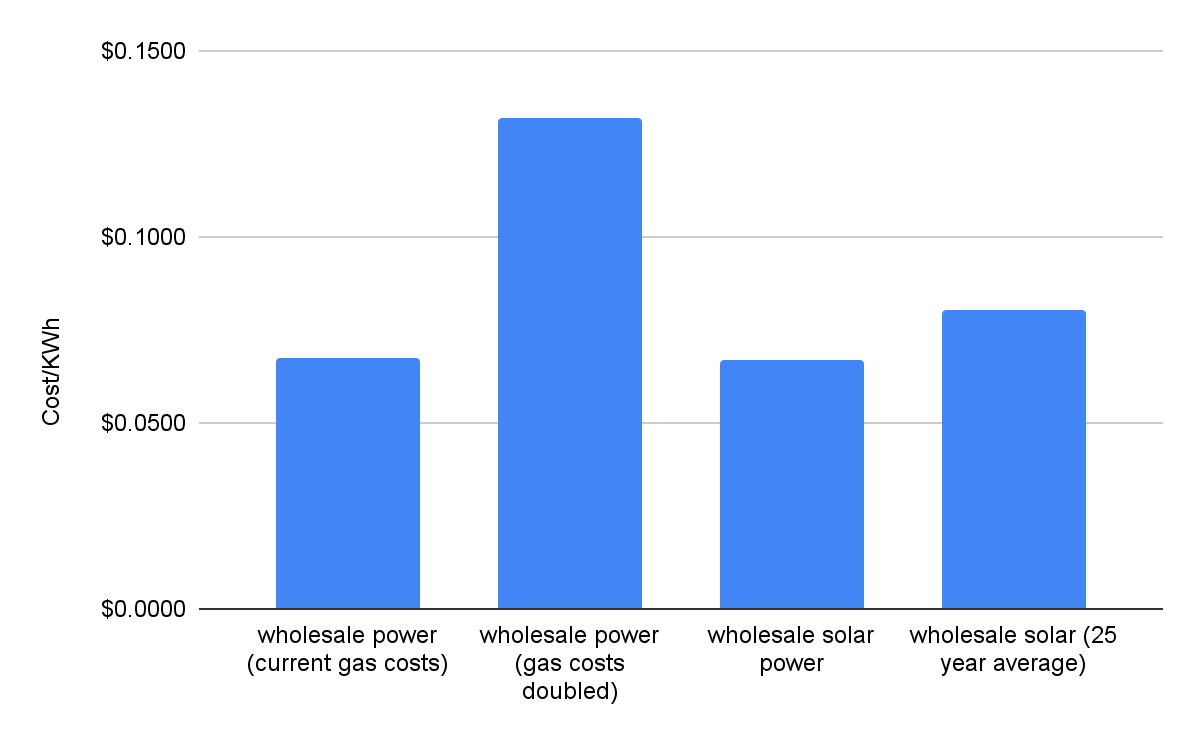Chugach’s proposed community solar tariff charges steep rates for a negligible amount of power
Electric utilities have much better options to increase renewable energy
Chugach Electric just filed a proposed community solar tariff with the RCA, which would sell solar power to subscribing customers for between 45 cents and 67 cents per kWh, substantially higher than current rates. Meanwhile, independent power producers can sell solar power wholesale on the Railbelt for around 7 cents per KWh.
What is community solar? It’s a model that sits in between home solar systems and utility-scale solar farms.
Home solar systems serve a single house, and much of the power they produce is used to offset power consumption, credited at retail rates.
Utility scale solar farms provide bulk wholesale power for a utility to distribute to all its customers. In Alaska, the largest such farm is RIPP’s Houston solar farm, which produces power equivalent to the consumption of around 1500 houses, and sells it to MEA at a rate below the cost of wholesale gas power. Other active proposals on the Railbelt would be much larger.
Community solar farms sell subscriptions to individuals, designed to imitate the effects of net metering for people who can’t install their own solar panels.
In an ideal world, community solar would
Meaningfully increase renewable energy generation.
Provide renewable energy that’s additional to and/or independent of utility efforts.
Provide access for lower income people and renters who can’t install solar panels.
Chugach’s proposed plan does none of those things.
Per kilowatt hour, the project is very expensive for subscribers
Chugach’s tariff proposes an initial subscription cost of $22.27 per panel per month, each of which is expected to produce 400 kWh of electricity per year. This results in a cost of $0.67 per kWh for the solar power. An average residential customer seeking to offset their entire consumption this way would roughly triple their electric bill.
Chugach expects to get a federal tax credit of 30% for their project, and will pass that to the subscribers. They also propose a declining rate for their subscription. Including both of those factors leads to a project lifetime ‘best case’ cost of $0.45 per kWh. A Chugach staff presentation last summer contemplated a somewhat cheaper price than they eventually put in the tariff — but even those preliminary predictions were quite expensive, around $0.37 per KWh.
The best case is nearly double Chugach’s current rates of $0.21/KWh.
Why is that? It’s not because solar power is inherently expensive.
Solar is actually quite cheap. Using the “Cost of Power Adjustment” as a rough approximation for wholesale power costs, Chugach’s current power costs (mostly gas power) are exactly the same as in the most recent Railbelt solar contract. And while those costs are likely to go up as gas costs rise, the solar contract price only increases a little.
Putting those two charts together, it’s clear that Chugach could buy wholesale solar power from an independent power provider, tack on the cost to distribute that power, and end up with something much cheaper than their community solar rate.
Solar isn’t expensive, but Chugach’s project is expensive.
This Chugach project is actually much more expensive per unit than rooftop solar. Total listed project costs are $2.7 million for a 576 kW project. That’s more than $4,500 per kW. Current prices for a rooftop solar system in Anchorage are around $3,200 to $3,400 per kW.
Why is Chugach’s project so expensive? I’ve already shown that the capital cost of the project is quite high relative to rooftop solar and IPP solar. A second part of the problem is how Chugach has chosen to structure their cost recovery. Here’s the issue in a nutshell, from an analysis by my blog partner Alan: Chugach plans to finance the project 100% with debt, making their interest payments quite high. Then they plan to collect a large margin component on top of this loan interest (amounting to 75% of interest payments). This margin component is not a cash expense and only serves to build up equity for the cooperative on the back of the community solar project. On a present value basis, over-recovery of costs relative to actual cash expenses amounts to $1.1 million or 39% of the capital cost of the project. Here is the link to Alan’s analysis.
The project is also so small as to be nearly meaningless: “generating electricity equivalent to an average of 0.02 percent of Chugach's retail energy sales annually.” Chugach is simultaneously pursuing utility scale wind and solar projects that are nearly 250 times the size of this community solar farm. Independent power producers are clearly able to build cost-effective solar in Alaska, and I’m sure they’d be happy to turn a 120 MW project into a 120.5 MW project if Chugach requested it.
Back to my three potential benefits of community solar… Does this:
meaningfully increase renewable energy generation? -- No -- 0.02% isn’t meaningful.
provide renewable energy that’s additional to and independent of utility efforts? -- No -- Chugach is spending money and effort on this plan that could be used for cheaper utility-scale solar, so it may lead to less solar overall.
provide access to lower income people and renters who can’t install solar panels? -- No -- because it’s much more expensive than baseline power.
Chugach’s surveys show that its members want community solar. But I’m assuming that what they want is actually one or all of the benefits I listed above.
Not only does this project not make sense, I don’t think that a community solar subscription program within a cooperative utility can ever make sense. Stay tuned for more on that in a later post.
This project is a distraction from the large utility-scale renewables that Chugach should be pursuing for all its members.




